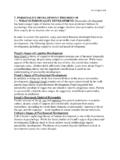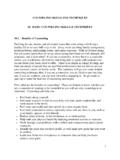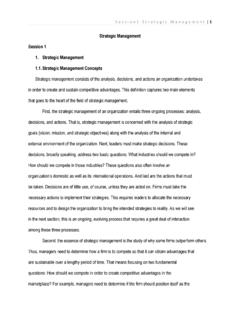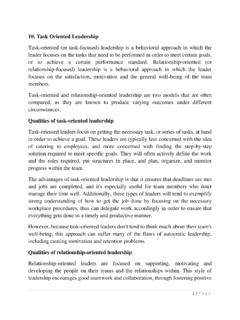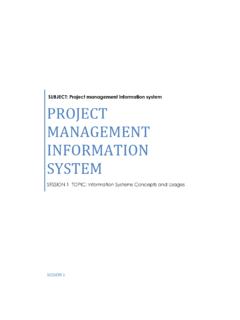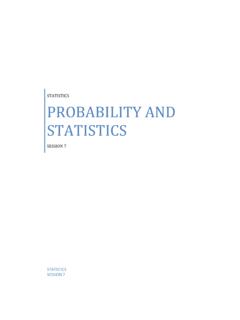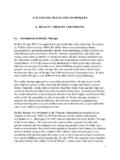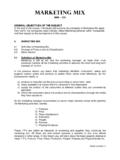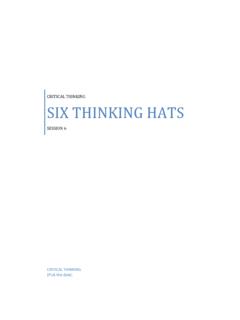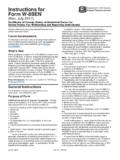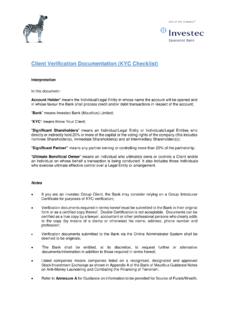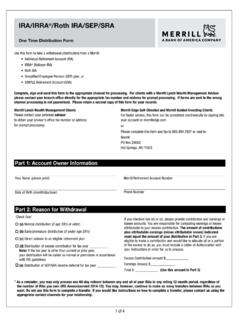Transcription of Product and Pricing Strategies
1 Product and Pricing Strategies MM 102. GENERAL OBJECTIVES OF THE SUBJECT. At the end of the course, individuals will examine the principles of Product & Pricing and apply them within the companies need critically reflect Marketing behavior within companies and their impact on the development of this course. 9. Product & Pricing Strategies . Overview of Products & Pricing Product Mix Stages of New Product Development Package & Label Pricing Strategy Breakeven Analysis Overview of Products & Pricing This lesson deals with the first two components of a marketing mix: Product strategy and Pricing strategy. Marketers broadly define a Product as a bundle of physical, service, and symbolic attributes designed to satisfy consumer wants.
2 Therefore, Product strategy involves considerably more than producing a physical good or service. It is a total Product concept that includes decisions about package design, brand name, trademarks, warranties, guarantees, Product image, and new- Product development. The second element of the marketing mix is Pricing strategy. Price is the exchange value of a good or service. An item is worth only what someone else is willing to pay for it. In a primitive society, the exchange value may be determined by trading a good for some other commodity. A horse may be worth ten coins; twelve apples may be worth two loaves of bread. More advanced societies use money for exchange.
3 But in either case, the price of a good or service is its exchange value. Pricing strategy deals with the multitude of factors that influence the setting of a price. This chapter begins by discussing the classification of goods and services, the Product mix, and the Product life cycle. We then explain how products are developed, identified, and packaged and the service attributes of products. The second part of the chapter focuses on the Pricing of goods and services, including Pricing objectives, how prices are set, and different types of Pricing Strategies . Classifying Goods and Services - Marketers have found it useful to classify goods and services because each type requires a different competitive strategy.
4 Goods and Product & Pricing Strategies | 1. Product and Pricing Strategies MM 102. services are classified as either consumer or industrial, depending on the purchaser and use of the particular item. Consumer and industrial Product classifications can also be subdivided. Classifying Consumer Goods - A variety of classifications have been suggested for consumer goods, but the system most typically used has three subcategories: convenience goods, shopping goods, and specialty goods. This system, based on consumer buying habits, has been used for about 70 years. Convenience goods are products the consumer seeks to purchase frequently, immediately, and with a minimum of effort.
5 Items stocked in 24-hour convenience stores, vending machines, and local newsstands are usually convenience goods. Newspapers, chewing gum, magazines, milk, beer, bread, and cigarettes are all convenience goods. Shopping goods are products purchased only after the consumer has compared competing goods in competing stores on bases such as price, quality, style, and color. A young couple intent on buying a new television may visit many stores, examine perhaps dozens of TV sets, and spend days making the final decision. The couple follows a regular routine from store to store in surveying competing offerings and ultimately selects the most appealing set.
6 Specialty goods are particular products desired by a purchaser who is familiar with the item sought and is willing to make a special effort to obtain it. A specialty good has no reasonable substitute in the mind of the buyer. The nearest BMW dealer may be 40. miles away, but a buyer might go there to obtain what they considers one of the world's best-engineered cars. This classification of consumer goods may differ among buyers. A shopping good for one person may be a convenience good for another. Majority buying patterns determine the item's Product classification. Marketing Strategy Implications - The consumer goods classification is a useful tool in marketing strategy.
7 For example, once a new lawn edger has been classified as a shopping good, insights are gained about its marketing needs in promotion, Pricing , and distribution methods. Classifying Industrial Goods - The five main categories of industrial goods are installations, accessory equipment, component parts and materials, raw materials, and supplies. While consumer goods are classified by buying habits, classification of industrial goods is based on how products are used and Product Product & Pricing Strategies | 2. Product and Pricing Strategies MM 102. characteristics. Goods that are long-lived and usually involve large sums of money are called capital items.
8 Less costly goods that are consumed within a year are referred to as expense items. Installations are major capital items such as new factories, heavy equipment and machinery, and custom-made equipment. Installations are typically used for the production of other items. For example, General Motors purchased an automated monorail system from Litton Industries to transport cars on the GM assembly line. Installations are expensive and often involve buyer/seller negotiations that may last several years before a purchase decision is made. Accessory equipment includes capital items that are usually less expensive and shorter-lived than installations.
9 Examples are hand tools and word processors. Some accessory equipment, such as a portable drill, is used to produce other goods and services, while other equipment, such as a desk calculator, is used in administrative and operating functions. Component parts and materials are industrial goods that become part of a final Product . Seagate Technology, for example, makes magnetic disk drives that are sold as a component part to manufacturers of small computers. In some cases, component parts are visible in the finished good, such as the Goodyear tires used on tractors or automobiles. In other cases, component parts and materials are not readily seen.
10 Raw materials are similar to component parts and materials because they are used in the production of a final good. Raw materials include farm products such as cotton, wheat, cattle, and milk, and natural materials such as iron ore, lumber, and coal. Because most raw materials are graded, buyers are assured of standardized products of uniform quality. Supplies are expense items used in a firm's daily operation, but they do not become part of the final Product . Supplies include products such as paper clips, cleaning compounds, light bulbs, stationery, and bailing wire. These items are purchased regularly and little time is spent on the purchase decision.
